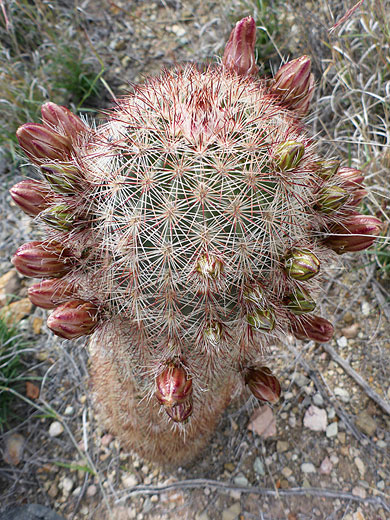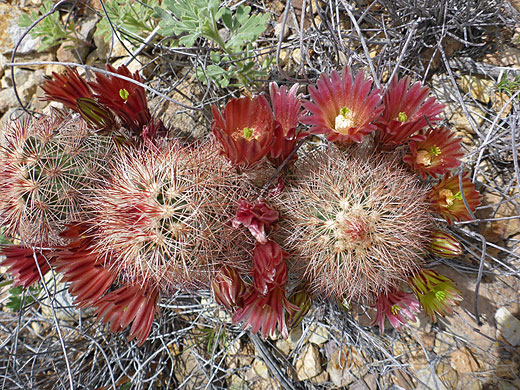Scientific name:
Echinocereus chloranthus, echinocereus viridiflorus var chloranthus
Common name:
Brown flowered cactus, green-flowered hedgehog cactus
Range:
South New Mexico, west Texas
Form:
Single, cylindrical stems, occasionally branched
Habitat:
Gravely slopes; full sun preferred
Flowers:
Red to brown, blooming early to middle spring, and growing in rings around the middle and lower parts of the plant

Distribution map for echinocereus chloranthus
Echinocereus chloranthus is an attractive species, growing up to ten inches tall (and 3 inches wide) and covered by dense brown, red or white spines; color is quite variable. The range is limited to certain locations in the Chihuahuan Desert of far south New Mexico and west Texas, in particular the Franklin Mountains of El Paso, along the Rio Grande and in Big Bend National Park, where the plant is locally quite commonplace, in all areas apart from the upper regions of the Chisos Mountains.
Ribs number between 11 to 16. The green stem color is largely hidden by the dense spines, of which there are three or four (less often five or six) centrals, up to 0.8 inches long, and 15 to 25 radials, at most half an inch long. Flowers are produced around the middle of the stem, and often almost down to the base; they have bronze, reddish-brown or greenish-brown tepals, with yellow filaments, creamy-yellow anthers and dark green stigma lobes. Fruits are small, rounded capsules, green to dull red, covered in small spines.
The plant is also classed as a variety of echinocereus viridiflorus, var chloranthus; it difers from the parent species in having denser spines, longer central spines, color banding of spines, taller stems, and flowers appearing lower down the stem.
Ribs number between 11 to 16. The green stem color is largely hidden by the dense spines, of which there are three or four (less often five or six) centrals, up to 0.8 inches long, and 15 to 25 radials, at most half an inch long. Flowers are produced around the middle of the stem, and often almost down to the base; they have bronze, reddish-brown or greenish-brown tepals, with yellow filaments, creamy-yellow anthers and dark green stigma lobes. Fruits are small, rounded capsules, green to dull red, covered in small spines.
The plant is also classed as a variety of echinocereus viridiflorus, var chloranthus; it difers from the parent species in having denser spines, longer central spines, color banding of spines, taller stems, and flowers appearing lower down the stem.
All Contents © Copyright The American Southwest | Comments and Questions | Contribute | Affiliate Marketing Disclosure | Site Map








